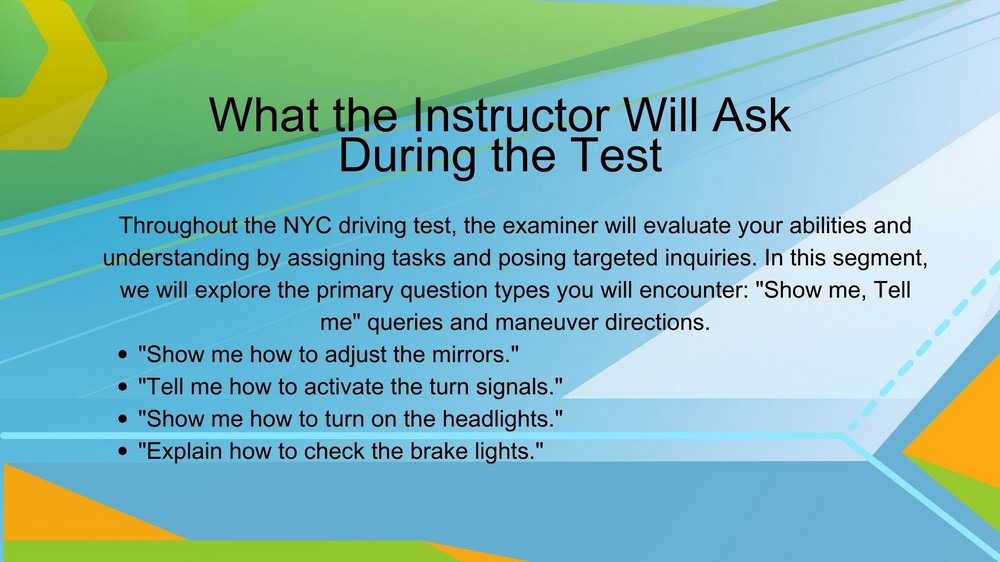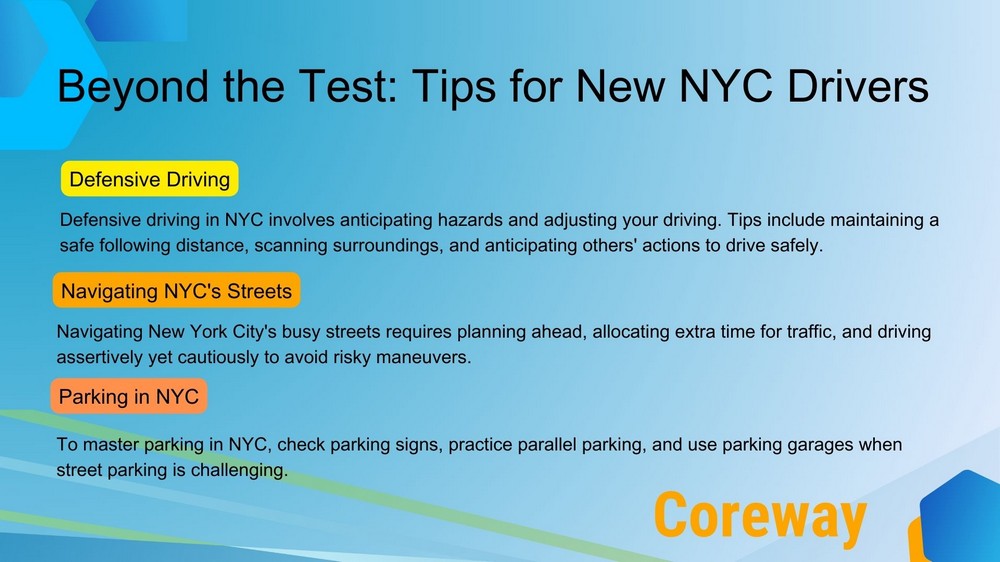What to expect in a NYC driving test?

Table of Contents
Schedule your road test at the Road Testing Center - Red Hook and take the next step toward your driver’s license!
Obtaining a driver's license in New York City is a significant milestone, but it requires passing the NYC driving test. For many new drivers, the uncertainty surrounding the test can be overwhelming. This comprehensive guide aims to alleviate those concerns by providing a detailed overview of the NYC driving test, including what to expect, how to prepare, and essential tips for success.
In this article, we'll cover the key aspects of the test, from the basic maneuvers you'll be asked to perform to the specific skills and knowledge required to pass. We'll also discuss common questions and concerns that new drivers often have about the test process. By the end of this guide, you'll have a solid understanding of what it takes to ace your NYC driving test and earn your driver's license.
Whether you're a first-time driver or someone who has recently relocated to New York City, this guide will provide you with the information and confidence you need to navigate the road test successfully. So, let's dive in and explore what you need to know to conquer the NYC driving test and become a licensed driver in the Big Apple.
What to Expect on the NYC Driving Test
Before diving into the details of the NYC driving test, it's essential to understand the overall structure of the exam. The test consists of two main parts: the written knowledge test and the road test. In this section, we'll focus on the road test, as the written test should be completed before scheduling your behind-the-wheel exam.
Breakdown of the Road Test
The NYC road test is designed to assess your ability to safely operate a vehicle in various driving situations. Here's what you can expect during the test:
- Pre-drive vehicle check: Before starting the test, your examiner will perform a vehicle inspection to ensure that your car is safe to drive. They will check the functioning of your headlights, brake lights, turn signals, and other essential components.
- "Show me, Tell me" questions: The examiner will ask you to demonstrate your knowledge of the vehicle's controls and safety features. They may ask you to turn on the headlights, activate the windshield wipers, or explain how to adjust the mirrors properly.
- Basic driving maneuvers: During the test, you'll be evaluated on your ability to perform essential driving skills, such as smooth acceleration and braking, turning, and maintaining proper lane position. The examiner will observe your steering control and use of turn signals throughout the test.
- Specific driving skills: You'll be required to demonstrate specific maneuvers, such as parallel parking and three-point turns. These skills are critical for navigating NYC's busy streets and tight parking spaces.
- Driving in real-world conditions: The road test will take place on actual NYC streets, exposing you to real-world traffic situations. You'll need to demonstrate your ability to navigate intersections, change lanes safely, and interact with other road users, including pedestrians and cyclists.
View our interactive map of all Brooklyn road test locations and their specific requirements.
Explore affordable ways to rent car for driving test near Brooklyn from trusted providers.
Key Skills Assessed During the Road Test
To help you better understand what the examiner will be looking for, here's a table summarizing the key skills assessed during the NYC road test:
|
Skill Category |
Specific Skills |
|
Vehicle Control |
- Smooth acceleration and braking - Proper steering techniques - Appropriate use of gears (if applicable) |
|
Traffic Awareness |
- Observing traffic signs and signals - Yielding right-of-way when necessary - Checking mirrors and blind spots |
|
Specific Maneuvers |
- Parallel parking - Three-point turns - Lane changes |
|
Defensive Driving |
- Maintaining a safe following distance - Anticipating other road users' actions - Adjusting speed for weather and road conditions |
Call Us Today 6AM-10PM
Or fill out the form 24/7
Our team is here to guide you with promotions, instructor availability, and the best training package for you.
What the Instructor Will Ask During the Test

During the NYC driving test, your instructor will ask you to perform various tasks and answer specific questions to assess your knowledge and skills. In this section, we'll cover the two main types of questions you can expect: "Show me, Tell me" questions and maneuver instructions.
"Show me, Tell me" Questions
The "Show me, Tell me" questions are designed to evaluate your understanding of the vehicle's controls and safety features. The instructor will ask you to demonstrate or explain how to perform specific functions. Some common questions include:
- "Show me how to adjust the mirrors."
- "Tell me how to activate the turn signals."
- "Show me how to turn on the headlights."
- "Explain how to check the brake lights."
To prepare for these questions, familiarize yourself with your vehicle's controls and practice demonstrating them confidently. Here's a table with some essential vehicle functions you should know:
|
Vehicle Function |
Description |
|
Headlights |
Know how to turn them on and off and switch between high and low beams. |
|
Turn Signals |
Demonstrate how to activate the left and right turn signals. |
|
Windshield Wipers |
Show how to turn on the wipers and adjust their speed. |
|
Hazard Lights |
Explain when and how to use the hazard lights. |
|
Horn |
Demonstrate how to honk the horn. |
Maneuver Instructions
Throughout the driving test, the instructor will give you specific instructions to guide you through the required maneuvers. These instructions may include:
- Turning: The instructor will ask you to make left and right turns at intersections. Remember to use your turn signals, check your mirrors and blind spots, and turn into the correct lane.
- Lane changes: You'll be asked to change lanes during the test. Signal your intention, check your mirrors and blind spots, and smoothly move into the desired lane when it's safe to do so.
- Parking: The instructor will ask you to perform specific parking maneuvers, such as parallel parking or pulling over to the side of the road. Practice these maneuvers beforehand to execute them confidently during the test.
- Three-point turns: You may be asked to perform a three-point turn to change direction in a narrow street or dead-end. Remember to check for traffic, signal your intentions, and execute the turn safely.
When the instructor gives you a maneuver instruction, take a moment to process the request and then execute it calmly and safely. If you're unsure about an instruction, don't hesitate to ask the instructor for clarification.
Essential Skills and Knowledge for the Test
To ace your NYC driving test, you must demonstrate proficiency in various driving skills and showcase your knowledge of traffic laws and safety practices. In this section, we'll break down the essential skills and knowledge you need to master before taking the test.
Basic Maneuvers
One of the most crucial aspects of the driving test is your ability to execute basic maneuvers smoothly and safely. Practice the following techniques:
- Accelerating: Gradually increase speed while maintaining control of the vehicle. Avoid jerky or abrupt acceleration.
- Braking: Come to a complete stop at stop signs and red lights. Brake smoothly and gradually when approaching intersections or slowing down.
- Turning: Signal your intention to turn, slow down, and turn into the correct lane. Use hand signals if necessary.
- Signaling: Always use your turn signals when changing lanes, turning, or pulling over. Signal early enough to give other drivers ample time to react.
Vehicle Operation
Before beginning the test, you'll need to perform a pre-drive vehicle check. Familiarize yourself with the following components:
- Lights (headlights, brake lights, turn signals)
- Tires (pressure, tread depth)
- Mirrors (proper adjustment)
- Windshield (clean and free of cracks)
- Seat adjustment and safety belts
Traffic Laws and Safety
To pass the NYC driving test, you must demonstrate a solid understanding of traffic laws and safe driving practices. Pay special attention to the following:
- Right-of-way: Yield to pedestrians and other vehicles when appropriate, such as at stop signs, crosswalks, and when turning.
- Speed limits: Always observe posted speed limits and adjust your speed according to traffic, weather, and road conditions.
- Following distance: Maintain a safe distance between your vehicle and the one in front of you. Use the "three-second rule" to ensure adequate space.
- Lane positioning: Keep your vehicle centered in your lane and avoid drifting. Use lane markings as a guide.
- Scanning: Continuously scan the road ahead, check your mirrors, and monitor your blind spots for potential hazards.
- Defensive driving: Anticipate the actions of other drivers, pedestrians, and cyclists. Be prepared to react to unexpected situations.
|
Traffic Law or Safety Practice |
Description |
|
Right-of-way |
Yield to pedestrians and other vehicles when required |
|
Speed limits |
Obey posted speed limits and adjust speed for conditions |
|
Following distance |
Maintain a safe distance using the "three-second rule" |
|
Lane positioning |
Keep your vehicle centered in your lane |
|
Scanning |
Continuously scan the road, mirrors, and blind spots |
|
Defensive driving |
Anticipate others' actions and be prepared to react |
Mastering the NYC Driving Test
Now that you understand the essential skills and knowledge required for the NYC driving test, let's explore some strategies to help you master the exam and increase your chances of success.
Practice Makes Perfect
One of the most effective ways to prepare for your driving test is to practice consistently. The more time you spend behind the wheel, the more comfortable and confident you'll feel on test day. Consider the following practice tips:
- Varied conditions: Practice driving in different weather conditions (e.g., rain, snow, fog) and at various times of day (e.g., daytime, nighttime) to gain experience in diverse situations.
- Different routes: Familiarize yourself with the test area by practicing on a variety of roads, including residential streets, highways, and busy intersections.
- Specific maneuvers: Dedicate time to practicing challenging maneuvers, such as parallel parking and three-point turns, until you can execute them confidently.
Familiarize Yourself with the Test Route
While the specific route used for your test may vary, it's helpful to familiarize yourself with the general area around your testing location. This knowledge can help you feel more at ease during the exam. However, don't rely solely on memorizing a single route, as the instructor may take you on a different path.
Stay Calm and Focused
Nerves can get the best of anyone during a driving test, but it's essential to stay calm and focused. Remember, the instructor is not trying to trick you or set you up for failure. They want to ensure that you possess the necessary skills to drive safely. Use these tips to maintain your composure:
- Take deep breaths: If you feel anxious, take a few deep breaths to help you relax and refocus.
- Don't dwell on mistakes: If you make a minor error, don't let it derail your entire test. Acknowledge it and move on, focusing on the next task at hand.
- Maintain a positive attitude: Believe in your abilities and approach the test with confidence. A positive mindset can help you stay focused and perform better.
|
Strategy |
Tips |
|
Practice |
- Drive in varied conditions - Familiarize yourself with different routes - Focus on specific maneuvers |
|
Test Route Familiarity |
- Familiarize yourself with the general test area - Don't rely solely on memorizing a single route |
|
Stay Calm and Focused |
- Take deep breaths to relax - Don't dwell on minor mistakes - Maintain a positive attitude |
Things to Remember on Your Road Test Day
With your practice and preparation complete, it's time to focus on the day of your NYC road test. By keeping a few key things in mind, you can ensure that you're ready to perform your best and achieve a successful outcome.
Documentation
Before leaving for your test, double-check that you have all the necessary documents:
- Learner's permit: Make sure your learner's permit is valid and hasn't expired.
- Proof of insurance: Bring a current insurance card for the vehicle you'll be using for the test.
- Vehicle registration: Ensure that the registration for your test vehicle is up to date.
Vehicle Preparation
To avoid any delays or issues on test day, prepare your vehicle beforehand:
- Check lights and signals: Test all lights (headlights, brake lights, turn signals) to ensure they're functioning properly.
- Adjust mirrors: Properly adjust your mirrors for maximum visibility.
- Check tire pressure: Make sure your tires are properly inflated and have sufficient tread depth.
- Clean windshield: Ensure your windshield is clean and free of any cracks or obstructions that could hinder visibility.
Dress Appropriately
While there's no strict dress code for the driving test, it's important to wear comfortable clothing and footwear that allows for easy movement and doesn't restrict your ability to operate the vehicle safely.
- Avoid restrictive clothing: Choose clothing that allows you to move freely and comfortably.
- Wear appropriate footwear: Opt for closed-toe shoes with a flat sole that provides good traction and control.
Arrival and Mindset
On the day of your test, plan to arrive at the testing location at least 15 minutes early. This will give you time to mentally prepare, relax, and get situated in your vehicle. Remember to:
- Stay calm: Take deep breaths and try to stay relaxed. Remember that you've prepared for this moment.
- Focus on the task at hand: Concentrate on demonstrating your driving skills and knowledge to the best of your ability.
- Listen carefully: Pay close attention to the instructor's directions and ask for clarification if needed.
|
Test Day Checklist |
Details |
|
Documentation |
- Valid learner's permit - Proof of insurance - Vehicle registration |
|
Vehicle Preparation |
- Check lights and signals - Adjust mirrors - Check tire pressure - Clean windshield |
|
Dress Appropriately |
- Wear comfortable, non-restrictive clothing - Choose appropriate footwear |
|
Arrival and Mindset |
- Arrive at least 15 minutes early - Stay calm and focused - Listen carefully to instructions |
Call Us Today 6AM-10PM
Or fill out the form 24/7
Our team is here to guide you with promotions, instructor availability, and the best training package for you.
Beyond the Test: Tips for New NYC Drivers

Congratulations on passing your NYC driving test! Earning your driver's license is a significant accomplishment, but it's just the beginning of your journey as a responsible driver on New York City's busy streets. To help you navigate the challenges of driving in the city, we've compiled some essential tips for new NYC drivers.
Defensive Driving
One of the most crucial skills for driving safely in NYC is defensive driving. This means anticipating potential hazards and adjusting your driving accordingly. Keep these tips in mind:
- Maintain a safe following distance: Always leave enough space between your vehicle and the one in front of you, especially in stop-and-go traffic.
- Scan your surroundings: Continuously monitor the road ahead, check your mirrors, and watch for pedestrians, cyclists, and other road users.
- Anticipate others' actions: Be prepared for sudden lane changes, stops, or turns from other drivers, and adjust your speed and position accordingly.
Navigating NYC's Streets
Driving in New York City can be challenging due to heavy traffic, narrow streets, and aggressive drivers. To help you navigate the city's streets with confidence, keep these tips in mind:
- Plan your route: Before setting out, familiarize yourself with your destination and plan your route to avoid any confusion or last-minute lane changes.
- Allow extra time: NYC traffic can be unpredictable, so always give yourself plenty of time to reach your destination.
- Be assertive but cautious: While it's important to drive confidently, don't let other drivers pressure you into making unsafe maneuvers.
Parking in NYC
Parking in New York City can be a daunting task, but with practice and patience, you'll master it in no time. Remember these tips:
- Read signs carefully: Always check parking signs for restrictions, such as alternate side parking or time limits.
- Practice parallel parking: Parallel parking is a essential skill in NYC, so practice it regularly to build your confidence.
- Consider parking garages: If you're having trouble finding street parking, look for parking garages or lots as an alternative.
|
Tip Category |
Key Points |
|
Defensive Driving |
- Maintain a safe following distance - Scan your surroundings - Anticipate others' actions |
|
Navigating NYC's Streets |
- Plan your route - Allow extra time - Be assertive but cautious |
|
Parking in NYC |
- Read signs carefully - Practice parallel parking - Consider parking garages |
Your Key to Becoming a Confident, Responsible Driver
Passing the NYC driving test is a significant milestone on your journey to becoming a licensed driver in New York City. By understanding the test's requirements, mastering essential driving skills, and following the tips and strategies outlined in this guide, you'll be well-prepared to conquer the challenges of the road test and earn your driver's license.
Remember, success on the driving test is a result of proper preparation, practice, and a positive mindset. By dedicating time to honing your driving skills, familiarizing yourself with traffic laws and safe driving practices, and practicing in various conditions, you'll be ready to demonstrate your competence and confidence behind the wheel.
On test day, stay focused, calm, and attentive to your instructor's directions. Trust in your preparation and skills, and approach the test with a positive attitude. Once you've passed the test and obtained your license, continue to prioritize safety and responsibility as you navigate the unique challenges of driving in New York City.
Call Us Today 6AM-10PM
Or fill out the form 24/7
Our team is here to guide you with promotions, instructor availability, and the best training package for you.
Frequently Asked Questions (FAQ)
To help address some of the most common concerns and questions about the NYC driving test, we've compiled a list of frequently asked questions and their answers.
-
1. What happens if I make a mistake during the road test?
Making a minor mistake, such as forgetting to signal once or slightly going over the speed limit, may result in a small point deduction but won't necessarily cause you to fail. However, major mistakes like running a red light, causing an accident, or committing a dangerous traffic violation will likely result in automatic failure.
-
2. Can I use my own vehicle for the road test?
Yes, you can use your own vehicle for the road test as long as it meets the DMV's requirements, such as having valid registration, insurance, and a current inspection sticker. Make sure to check your vehicle beforehand to ensure it's in proper working order.
-
3. How long does the road test take?
The actual driving portion of the road test typically takes about 15-20 minutes. However, plan for additional time to complete paperwork, wait for your turn, and receive your results.
-
4. What should I do if I fail the road test?
If you fail the road test, don't be discouraged. The examiner will provide you with feedback on the areas where you need improvement. Take note of these areas and focus on practicing them before scheduling a retest. In most cases, you'll have to wait a certain period before retaking the test, so use this time to hone your skills and build your confidence.
-
5. Can I take the road test if I have a foreign driver's license?
If you have a valid driver's license from another country, you may be able to waive the road test requirement and exchange your foreign license for a New York State license. However, this depends on the country where your license was issued and other factors. Check with the DMV for specific requirements and eligibility.
 English
English Spanish
Spanish 

